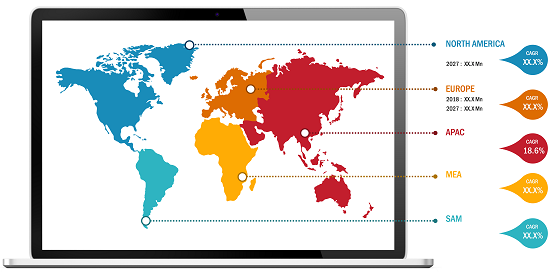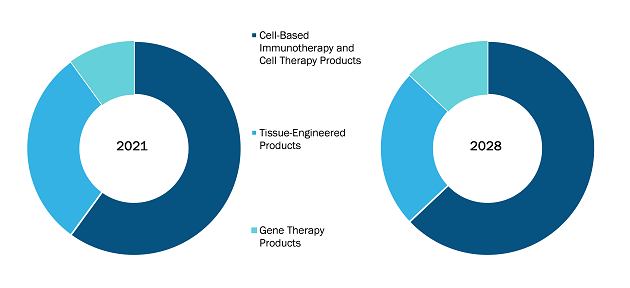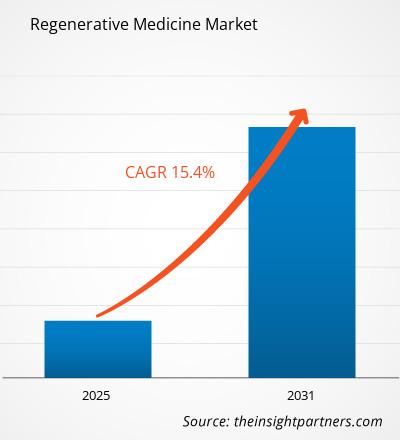Le marché de la médecine régénérative était évalué à 11,77 milliards de dollars en 2021 et devrait atteindre les États-Unis. 37,48 milliards de dollars d’ici 2031 ; il devrait croître à un TCAC de 17,9 % de 2022 à 2031.
La médecine régénérative est un domaine innovant de la médecine qui développe des méthodes pour remplacer/régénérer les cellules, tissus ou organes humains afin de restaurer des fonctions normales. Il peut guérir les tissus ou les organes en stimulant les mécanismes de réparation du corps. La médecine régénérative permet aux scientifiques de cultiver des tissus et des organes en laboratoire et de les implanter en toute sécurité dans le corps lorsque celui-ci ne peut pas se guérir tout seul.
Adoption croissante des thérapies géniques, des thérapies par cellules souches et de l'ingénierie tissulaire ; nombre croissant d'approbations pour les thérapies cellulaires et géniques ; et les progrès technologiques dans le domaine de la médecine régénérative sont les facteurs clés de la croissance du marché. Cependant, le coût élevé de ces thérapies entrave l'expansion du marché.
Le marché de la médecine régénérative est analysé sur la base du type, application et géographie. Le rapport offre des informations et une analyse approfondie du marché de la médecine régénérative, en mettant l'accent sur divers paramètres tels que les tendances du marché, les progrès technologiques et la dynamique du marché, ainsi que sur l'analyse du paysage concurrentiel des principaux acteurs du marché.
Aperçus stratégiques
Régions lucratives du marché de la médecine régénérative

Le nombre croissant d'approbations de thérapies cellulaires et géniques renforce la croissance du marché de la médecine régénérative
Le nombre croissant de thérapies cellulaires et géniques est susceptible de stimuler la croissance du marché. Par exemple, en mai 2022, la Food and Drug Administration (FDA) des États-Unis a approuvé la thérapie cellulaire CAR-T Novartis Kymriah pour les patients adultes atteints d'un lymphome folliculaire (FL) en rechute ou réfractaire (r/r). Kymriah est la première thérapie cellulaire CAR-T approuvée développée conjointement par Novartis et la Perelman School of Medicine de l'Université de Pennsylvanie. En février 2022, Janssen Biotech, Inc a reçu l'approbation de la FDA américaine pour son CARVYKTI (ciltacabtagene autoleucel ; cilta-cel) destiné au traitement des adultes atteints de myélome multiple récidivant ou réfractaire.
- En août 2022, Bluebird Bio, Inc. a reçu l'approbation de la FDA américaine pour son Zynteglo (betibeglogene autotemcel), la première cible de thérapie génique pour traiter les patients adultes et pédiatriques souffrant de bêta-thalassémie qui nécessitent régulièrement des transfusions de globules rouges.
- En mars 2021, la FDA américaine a approuvé Celgene Abecma (idecabtagene vicleucel) de Corporation, une thérapie génique cellulaire destinée au traitement des patients adultes atteints de myélome multiple qui n'ont pas répondu au traitement ou dont la maladie a rechuté même après différents types de thérapies.
En fonction du type, le marché de la médecine régénérative est divisé en produits d'immunothérapie et de thérapie cellulaire à base de cellules, produits issus de l'ingénierie tissulaire et produits de thérapie génique. L'le segment des produits d'immunothérapie et de thérapie cellulaire détenait la plus grande part de marché en 2021 et devrait enregistrer le TCAC le plus élevé au cours de la période de prévision.
Marché de la médecine régénérative, par type - 2021 et 2031

Insights basés sur les applications
En fonction des applications, le marché de la médecine régénérative est segmenté en troubles musculo-squelettiques, soins des plaies, oncologie, troubles oculaires et diabète. Le segment de l'oncologie occupait la plus grande part de marché en 2021 et devrait enregistrer la plus élevée. TCAC entre 2022 et 2031.
La pandémie de COVID-19 a créé des opportunités de croissance pour les acteurs du marché en raison de l'urgence de développer de nouvelles thérapies pour les patients atteints de COVID-19. Plusieurs projets de recherche ont été lancés dans le secteur de la recherche en thérapie cellulaire et génique. Par exemple , en novembre 2021, Longeveron Inc. a lancé son essai de phase 1 pour tester la sécurité des cellules souches mésenchymateuses de Longeveron (LMSC) chez les adultes souffrant du syndrome de détresse respiratoire aiguë (SDRA) léger à sévère dû au COVID-19.< /p>
En 2022, l’Amérique du Nord détenait la plus grande part du marché de la médecine régénérative. La croissance du marché est attribuée à l’augmentation des activités de recherche et développement dans le domaine de la médecine régénérative. L’Asie-Pacifique devrait enregistrer le plus rapide TCAC au cours de la période de prévision. La Chine, le Japon et l’Inde sont les principaux contributeurs au marché de la médecine régénérative dans la région. La recherche croissante sur les cellules souches, le soutien croissant du gouvernement à la recherche sur les cellules et les gènes et les améliorations des infrastructures biotechnologiques sont les facteurs à l’origine du croissance du marché en APAC.
Par géographie, le marché de la médecine régénérative est segmenté en Amérique du Nord (États-Unis, Canada et Mexique), en Europe (Royaume-Uni, Allemagne, France, Italie, Espagne et reste de l'Europe), Asie-Pacifique (Chine, Japon, Inde, Corée du Sud, Australie et reste de l'Asie-Pacifique), Moyen-Orient et Afrique (EAU, Arabie saoudite, Afrique et reste du Moyen-Orient et de l'Afrique) et Sud et Amérique centrale (Brésil, Argentine et reste de l'Amérique du Sud et centrale).
Profils d'entreprise
- Integra LifeSciences
- Gilead Sciences, Inc.
- Novartis AG
- Vericel Corporation
- Wright Medical Group NV
- MiMedx Group
- Osiris Therapeutics, Inc.
- Stryker Corporation
- Spark Therapeutics, Inc.
- Medtronic plc
- Analyse historique (2 ans), année de base, prévision (7 ans) avec TCAC
- Analyse PEST et SWO
- Taille du marché Valeur / Volume - Mondial, Régional, Pays
- Industrie et paysage concurrentiel
- Ensemble de données Excel



Report Coverage
Revenue forecast, Company Analysis, Industry landscape, Growth factors, and Trends

Segment Covered
This text is related
to segments covered.

Regional Scope
North America, Europe, Asia Pacific, Middle East & Africa, South & Central America

Country Scope
This text is related
to country scope.
Questions fréquemment posées
Some of the customization options available based on request are additional 3-5 company profiles and country-specific analysis of 3-5 countries of your choice. Customizations are to be requested/discussed before making final order confirmation, as our team would review the same and check the feasibility.
The report can be delivered in PDF/PPT format; we can also share excel dataset based on the request.
Key companies in this market are: Integra LifeSciences Corporation, Gilead Sciences, Novartis, Vericel Corporation, Wright Medical MiMedx, Osiris Therapeutics, Stryker Corporation, Spark Therapeutics
The Regenerative Medicine Market is expected to register a CAGR of 15.4% from 2023-2031.
Key future trends in this market are - Increase in stem cell research, Adoption of 3D bioprinting, Advances in tissue engineering
The major factors impacting the Regenerative Medicine Market are: Growing Focus on Stem Cell Research, Rising Prevalence of Chronic Diseases, and Advancements in Gene Therapy
Trends and growth analysis reports related to Life Sciences : READ MORE..
The List of Companies
1. Integra LifeSciences Corporation
2. Gilead Sciences
3. Novartis
4. Vericel Corporation
5. Wright Medical
6. MiMedx
7. Osiris Therapeutics
8. Stryker Corporation
9. Spark Therapeutics
10. Medtronic
11. 3M
12. Allergan Plc
13. Aspect Biosystems
14. Bluebird Bio
15. Amgen, Inc.
16. Smith and Nephew Plc
17. Corestem, Inc.
18. Organogenesis
19. Kite Pharma
20. Spark Therapeutics
The Insight Partners performs research in 4 major stages: Data Collection & Secondary Research, Primary Research, Data Analysis and Data Triangulation & Final Review.
- Data Collection and Secondary Research:
As a market research and consulting firm operating from a decade, we have published and advised several client across the globe. First step for any study will start with an assessment of currently available data and insights from existing reports. Further, historical and current market information is collected from Investor Presentations, Annual Reports, SEC Filings, etc., and other information related to company’s performance and market positioning are gathered from Paid Databases (Factiva, Hoovers, and Reuters) and various other publications available in public domain.
Several associations trade associates, technical forums, institutes, societies and organization are accessed to gain technical as well as market related insights through their publications such as research papers, blogs and press releases related to the studies are referred to get cues about the market. Further, white papers, journals, magazines, and other news articles published in last 3 years are scrutinized and analyzed to understand the current market trends.
- Primary Research:
The primarily interview analysis comprise of data obtained from industry participants interview and answers to survey questions gathered by in-house primary team.
For primary research, interviews are conducted with industry experts/CEOs/Marketing Managers/VPs/Subject Matter Experts from both demand and supply side to get a 360-degree view of the market. The primary team conducts several interviews based on the complexity of the markets to understand the various market trends and dynamics which makes research more credible and precise.
A typical research interview fulfils the following functions:
- Provides first-hand information on the market size, market trends, growth trends, competitive landscape, and outlook
- Validates and strengthens in-house secondary research findings
- Develops the analysis team’s expertise and market understanding
Primary research involves email interactions and telephone interviews for each market, category, segment, and sub-segment across geographies. The participants who typically take part in such a process include, but are not limited to:
- Industry participants: VPs, business development managers, market intelligence managers and national sales managers
- Outside experts: Valuation experts, research analysts and key opinion leaders specializing in the electronics and semiconductor industry.
Below is the breakup of our primary respondents by company, designation, and region:

Once we receive the confirmation from primary research sources or primary respondents, we finalize the base year market estimation and forecast the data as per the macroeconomic and microeconomic factors assessed during data collection.
- Data Analysis:
Once data is validated through both secondary as well as primary respondents, we finalize the market estimations by hypothesis formulation and factor analysis at regional and country level.
- Macro-Economic Factor Analysis:
We analyse macroeconomic indicators such the gross domestic product (GDP), increase in the demand for goods and services across industries, technological advancement, regional economic growth, governmental policies, the influence of COVID-19, PEST analysis, and other aspects. This analysis aids in setting benchmarks for various nations/regions and approximating market splits. Additionally, the general trend of the aforementioned components aid in determining the market's development possibilities.
- Country Level Data:
Various factors that are especially aligned to the country are taken into account to determine the market size for a certain area and country, including the presence of vendors, such as headquarters and offices, the country's GDP, demand patterns, and industry growth. To comprehend the market dynamics for the nation, a number of growth variables, inhibitors, application areas, and current market trends are researched. The aforementioned elements aid in determining the country's overall market's growth potential.
- Company Profile:
The “Table of Contents” is formulated by listing and analyzing more than 25 - 30 companies operating in the market ecosystem across geographies. However, we profile only 10 companies as a standard practice in our syndicate reports. These 10 companies comprise leading, emerging, and regional players. Nonetheless, our analysis is not restricted to the 10 listed companies, we also analyze other companies present in the market to develop a holistic view and understand the prevailing trends. The “Company Profiles” section in the report covers key facts, business description, products & services, financial information, SWOT analysis, and key developments. The financial information presented is extracted from the annual reports and official documents of the publicly listed companies. Upon collecting the information for the sections of respective companies, we verify them via various primary sources and then compile the data in respective company profiles. The company level information helps us in deriving the base number as well as in forecasting the market size.
- Developing Base Number:
Aggregation of sales statistics (2020-2022) and macro-economic factor, and other secondary and primary research insights are utilized to arrive at base number and related market shares for 2022. The data gaps are identified in this step and relevant market data is analyzed, collected from paid primary interviews or databases. On finalizing the base year market size, forecasts are developed on the basis of macro-economic, industry and market growth factors and company level analysis.
- Data Triangulation and Final Review:
The market findings and base year market size calculations are validated from supply as well as demand side. Demand side validations are based on macro-economic factor analysis and benchmarks for respective regions and countries. In case of supply side validations, revenues of major companies are estimated (in case not available) based on industry benchmark, approximate number of employees, product portfolio, and primary interviews revenues are gathered. Further revenue from target product/service segment is assessed to avoid overshooting of market statistics. In case of heavy deviations between supply and demand side values, all thes steps are repeated to achieve synchronization.
We follow an iterative model, wherein we share our research findings with Subject Matter Experts (SME’s) and Key Opinion Leaders (KOLs) until consensus view of the market is not formulated – this model negates any drastic deviation in the opinions of experts. Only validated and universally acceptable research findings are quoted in our reports.
We have important check points that we use to validate our research findings – which we call – data triangulation, where we validate the information, we generate from secondary sources with primary interviews and then we re-validate with our internal data bases and Subject matter experts. This comprehensive model enables us to deliver high quality, reliable data in shortest possible time.

 Obtenez un échantillon gratuit pour ce rapport
Obtenez un échantillon gratuit pour ce rapport